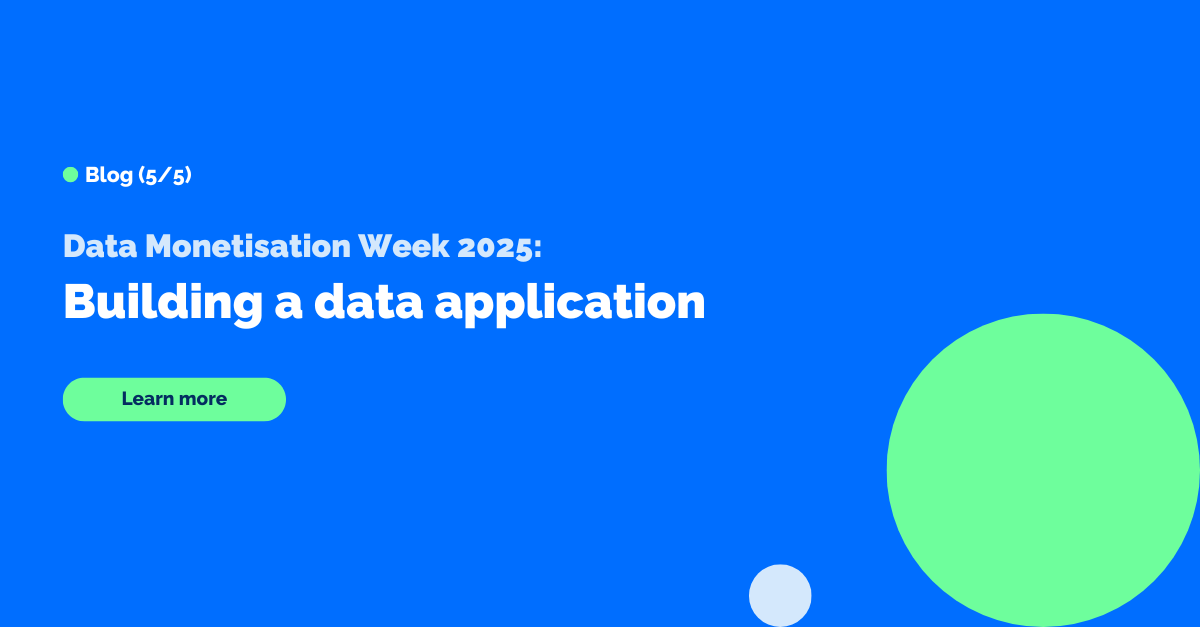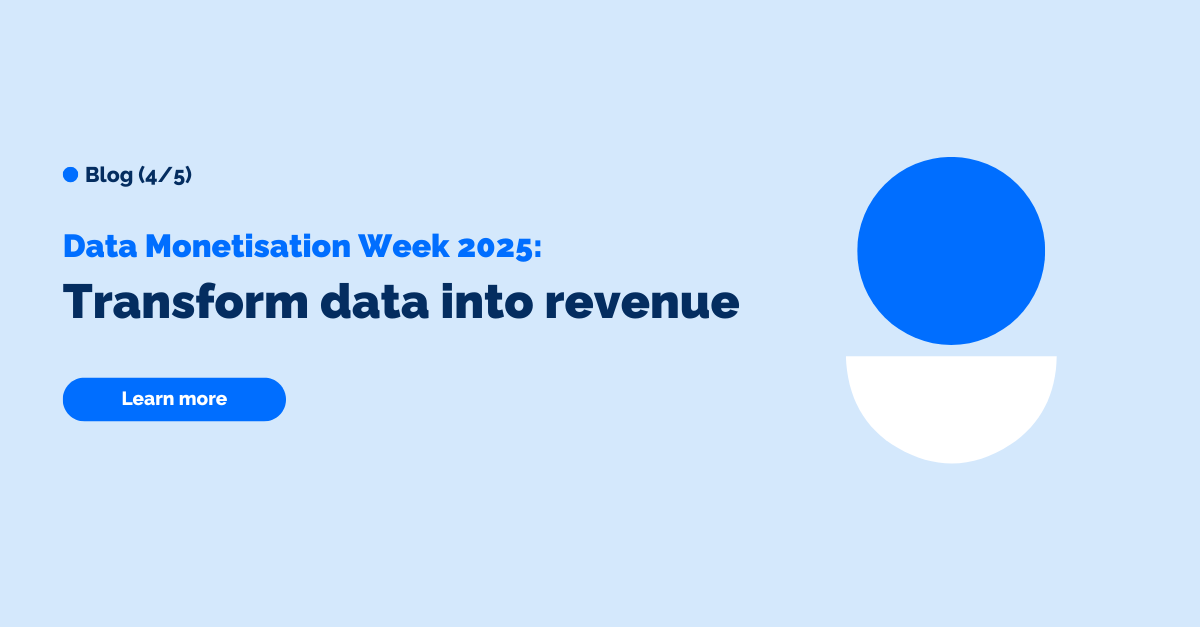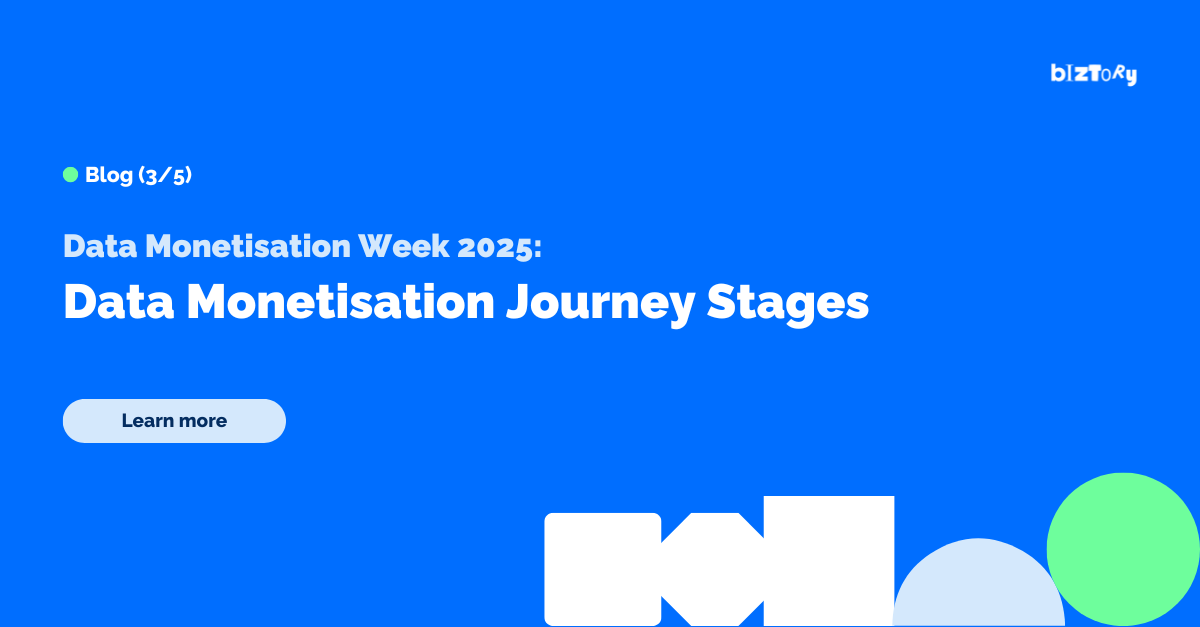Over the past few days, we’ve covered what data monetisation is, explored different models, and discussed the stages involved in building a data monetisation strategy. By now, you should have a strong understanding of the various ways data can create value. Today, on Day 4 of Data Monetisation Week 2025, we’ll dig into the practical steps for turning data into revenue.
From establishing a data infrastructure to identifying revenue opportunities, we’ll examine what it takes to transform data from a valuable resource into an active revenue stream. Whether you’re monetising directly by offering data products or indirectly through embedded insights, this guide will provide actionable insights to help you start generating ROI from your data.
Day 1: What is Data Monetisation?
Day 2: Data Monetisation Models
Day 3: The 4 stages of Data Monetisation
Day 4: How to turn data into revenue
Day 5: Building a data application
No time to read? Listen to the podcast instead.
1. Indirect Data Monetisation
You don’t have to pass on the cost of analytics to your customers, or charge them directly for it in order to monetise your data. Indirect data monetisation is not about selling your data directly.
It’s more about enhancing your core product, rather than building a new offering. Charging customers for data and insights can be a shortcut to monetise your data, yes - but it’s not always the best strategy for it.
Instead, there are many different ways where you can use data monetisation to generate monetary value indirectly. Think increased acquisition rates, improved conversion rates, and higher engagement and retention with your product.
One of our favourite examples of indirect data monetisation is Spotify’s Wrapped initiative - that shows you as a user of the platform, what your year on Spotify was like - what different artists you discovered, what songs you listened to most, your favourite genres, etc.
It’s not a paid feature on Spotify. But it drives enormous indirect value for Spotify by significantly increasing user engagement, driving retention & adoption - and most of all it drives tons of brand recognition by everyone sharing their stats on social media with their friends.
2. Direct Data Monetisation
Direct data monetisation is a lot easier to understand, as the value you’re getting from your data is a lot more tangible. Here, you are actually charging your customers for access to data or insights, and creating a separate revenue stream.
This is where your “monetisation strategy” comes into play. How will you generate revenue from your data? What packages will you offer? How do you tier these packages? What pricing will you charge
You’ll need to formulate an answer to all of these strategic questions when you’re looking to scale your direct data monetisation use case.
Essentially it all boils down to defining what your Data as a Product or Service packages will look like. Using tiered pricing and packaged offerings like SaaS companies usually do is a good place to start if you’re looking for inspiration.
Let’s dig deeper…
2.1 Defining your pricing strategy
When you’re selling something, setting the right pricing is crucial for success. Aim too high, and you might lose your customers. Aim too low, and you might set yourself up for failure.
As with every product or service, there are different ways to set a pricing for your data, each with its own benefits. The main two strategies for data monetisation use cases are cost pricing and value-based pricing.
Option #1: Cost pricing
With cost pricing, it’s essential to have a clear understanding of your costs for data collection, storage, preparation, transformation and sharing.
You want to know exactly how much costs are involved there, because with cost pricing, you’ll simply be adding a margin percentage to price your data product or service above its cost.
Does that mean you should always strive to set that margin % at a level that maximises revenue?
Not at all.
Circling back to indirect data monetisation, if your goal is not to maximise revenue, but rather to use the offering to acquire new customers faster so you can upsell them your true revenue and margin drivers, you might want to price your data at or below cost. You could even give some of it away for free as a way to lower the entry-barrier and increase your conversion rates.
Option #2: Value-based pricing
With value-based pricing, you look beyond the cost of your data product or service. You switch to the perspective of your customer and try to quantify the value they’re getting out of your solution. Things to consider here include:
The uniqueness of your product or service: How unique is the data and your solution to the customers? How easy is it to find alternatives to your solution? The more unique, the higher you can set the price.
Accessibility: How difficult is it for customers to access the data or insights you’re providing them? If you’re removing specific barriers, making it easier for customers to access the desired data or insights, the higher you can set the price.
Insights & expertise: Is aggregating and analysing this data difficult and time consuming? What time and effort are you saving for your customers? How much are you saving them in terms of costs if they were to rely on other solutions like consultants to obtain similar insights?
Stickiness & value: Lastly, how much value is your solution generating for customers? Do the insights you provide give them a competitive advantage, too? Can they make better decisions off the back of it? Could it help them develop better products or services?
2.2 Building your package
The final element is to bring all of it together in different packages you’ll be offering to the market. Determining costs and value is helpful when building different pricing tiers.
Tiered pricing starts with first defining the set of benefits or features that will make your packaged offering or solution. Think of things like level of customisation, actionability, granularity, etc… The classic “good, better, best” framework is a great place to start.
|
Good |
Better |
Best |
|
|
Historical data |
3 - 9 months |
9 - 23 months |
24+ months |
|
Data granularity |
aggregated |
row-level |
Row & column level |
|
Data richness / attributes |
Static reporting |
Self-service exploration |
Build reports, schedule actions & alerts |
|
Customisation |
None |
filters |
Metrics, filters, reports |
|
End-user rights |
View only |
Explore only |
Automated actions |
A tiered pricing strategy can help you attract new users by offering your solution at a lower entry cost. Again, you could consider a freemium model featuring limited teaser access for new customers that will be “wanting more”.
With your packages defined, you’ll also need to decide whether to sell data by the set, on a subscription basis, or maybe even by consumption.
Conclusion
As we wrap up today’s deep dive into transforming data into revenue on Day 4 of Data Monetisation Week 2025, we've traversed from the theoretical foundations right into the tangible steps of monetising your data. Whether you’re intrigued by the subtle strategy of indirect data monetisation or the more direct approach of selling data products, there are strategic pathways for each business to explore and leverage.
Indirect data monetisation, exemplified by initiatives like Spotify’s Wrapped, shows how data can enhance your core offerings and foster deeper engagement without direct charges. This approach doesn’t just drive brand visibility; it enriches user experience and cements customer loyalty, transforming engagement into a powerful engine of retention and organic growth.
On the flip side, direct data monetisation demands a nuanced strategy in pricing and packaging. Whether you opt for cost pricing to cover your data handling expenses or pursue value-based pricing to reflect the unique insights your data provides, the key is alignment with your overall business goals. Setting up tiered pricing packages, much like SaaS offerings, allows flexibility and accessibility, catering to a broader range of customers from those just dipping their toes in the data pool to those ready for the deep dive.
Choosing the right pricing and packaging strategy isn’t just about covering costs or maximising profit; it’s about positioning your data products in a way that aligns with your customer's needs and your strategic objectives. As you develop your data monetisation packages, consider not only the data’s cost and intrinsic value but also how it fits into your larger market offering.
So, as we move towards Day 5, where we will explore data applications, remember that the journey of data monetisation is not a one-size-fits-all. It's a tailored suit, designed to fit your business model, driven by the unique needs of your customers, and stitched with the threads of your specific market dynamics.




